
Melicytus ramiflorus is a small tree of the family Violaceae endemic to New Zealand.
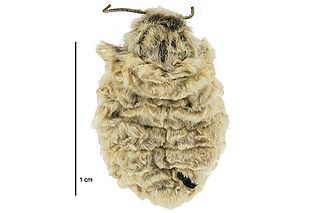
Metacrias is a genus of moths in the family Erebidae. All species are endemic to New Zealand.

The green blotched moth is a moth of the family Noctuidae. It is found in New South Wales, Norfolk Island, Queensland, South Australia, Victoria, Western Australia and New Zealand.

Uresiphita ornithopteralis, the tree lucerne moth, is a moth of the family Crambidae. It was described by Achille Guenée in 1854. It is found in New South Wales, Norfolk Island, Queensland, Victoria, South Australia, Tasmania and Western Australia. It is also found in New Zealand.

Austramathes is a genus of moths of the family Noctuidae. It is endemic to New Zealand.

Physetica is a genus of moths of the family Noctuidae. This genus is endemic to New Zealand.
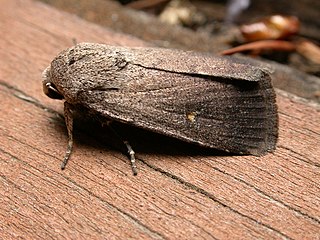
Proteuxoa is a genus of moths of the family Noctuidae. The genus was erected by George Hampson in 1903.

Ctenoplusia limbirena, the Scar Bank gem, or silver U-tail, is a moth of the family Noctuidae. It is found in south-western Europe, Africa, the Canary Islands, Arabia, the southern Himalayas, India, Sri Lanka, Indochina to south-eastern China, Taiwan, Sulawesi, Bali and Timor. In New Zealand, it has been established since 2011.

Australothis volatilis, also known as the fuzzweed moth, is a species of moth in the family Noctuidae. It is endemic to New Zealand. This species has been classified as critically endangered by the Department of Conservation.

Melicytus lanceolatus, commonly called narrow-leaved māhoe or māhoe-wao, is a small tree of the family Violaceae endemic to New Zealand.

Meterana pictula is a moth of the family Noctuidae. It is endemic to New Zealand. This species has been classified as "At Risk, Declining" by the Department of Conservation.

Proteuxoa comma is a species of moth in the family Noctuidae. It is endemic to New Zealand. It can be found in the lower half of the North Island and throughout the South Island, although it appears to be more frequent on the eastern side of these islands, and also is present in Stewart Island. P. comma is very similar in appearance to P. tetronycha but can be distinguished as it is a larger moth with slightly different colouration on, as well as shape of, its forewings. This species pupates in the soil. The adult moths are on the wing from December to April. P. comma may possibly be declining in population and as at 2017 a reassessment of its conservation status is regarded as being needed.
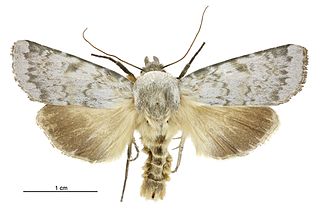
Physetica caerulea is a species of moth of the family Noctuidae. It is endemic to New Zealand and can be found from the centre of the North Island south, including the South and Stewart Islands. The adult moths are variable in appearance but can be distinguished by the bluish tinge to the forewings as well as the underside buff colour. However this species does have several forms including a very dark bluish black form, a brownish form and a green-brown form. It lives in open habitats and can be found in tussock grasslands and dunes and can normally be found from altitudes of sea level up to 900 m. Adults of this species are on the wing from August to April. As at 2017, the life history of is unknown as are the host species of its larvae. However it has been hypothesised that the larval host species is a tomentose plant.

Austramathes pessota is a species of moth in the family Noctuidae. It is endemic to New Zealand and is found in Northland, in the southern North Island and in the South Island, mainly on the eastern side of that island but is also present in Fiordland. It is not regarded as being present in either Dunedin or the Southland district. This species lives in shrubland at altitudes ranging from sea-level up to subalpine. As at 2017, the larvae have yet to be described or photographed but it is known that they feed on Melicytus alpinus and it is likely that Melicytus micranthus is also a host. Adults of this species are distinctively patterned and coloured. Its appearance differs from its close relatives such as A. purpurea as it lacks the purple hue that can be seen on the latter species forewings. It also differs from A. coelacantha as it is much darker and has a distinctive small, round, pale mark on its forewing. Adults are on the wing from December to April.

Austramathes squaliolus is a species of moth in the family Noctuidae. It is endemic to New Zealand and is found only in the Chatham Islands on the Chatham, Pitt, Little Mangere and Rangatira Islands. The larvae of A. squaliolus is similarly patterned to the larvae of A. fortis and have lateral yellow markings that contrast with the dark dorsal marbling. However this marbling is darker in A. squaliolus in comparison to the lighter coloured A. fortis. Melicytus chathamicus is the larval host-plant for this species. The adult moth is again very similar in appearance to A. fortis and, as with A. fortis, the black line curved at the forewing base is the distinguishing feature. However the two species are unlikely to be confused as their ranges do not overlap. The adult moths are on the wing in November and December and have been observed flying at dusk.
Austramathes coelacantha is a species of moth in the family Noctuidae. It is endemic to New Zealand and is found in the central and east of the South Island. It lives in shrubland in inland areas as well as in Southern beech forest at subalpine altitudes. The life history of this species is unknown as are the host species of its larvae. However the larval host-plants may be species within the genus of Melicytus. Adult moths are on the wing during the months of January to March. They are attracted to light and appear to be active later in the evening, and not at twilight.
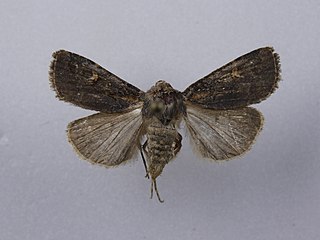
Proteuxoa tetronycha is a moth of the family Noctuidae. It is endemic, and can be found throughout, New Zealand. This species was previously muddled up with the rarer Proteuxoa comma and is very similar in appearance to that other species. P. tetronycha can be distinguished from P. comma by the paler colour of its prothorax as well as the browner base colour of its forewings. P. tetronycha is also a smaller moth with the wingspan of the adults of this species being between 29 and 33 mm. There are also differences between the females of these two species. For the females of P. tetronycha, their ovipositor is lacking the spiny hair like structures that are present on the ovipositor of P. comma. Larvae likely feed on a variety of host species and have been raised on Acaena species as well as Poa cita. The adults of this species are on the wing from September to March and are attracted to light.
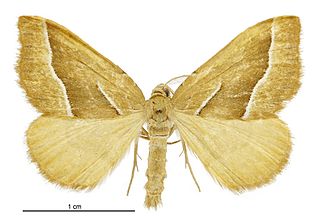
Asaphodes stinaria is a moth in the family Geometridae. It is endemic to New Zealand and has previously been observed in both the North and South Islands. The range of this species has contracted and it has recently only been located in Westland, Otago and Southland. This species inhabits wetlands, tussock country, and in grassy openings in native forest. The larval host species has been hypothesised as being 'hairy' Ranunculus species however as at 2000 this hasn't been confirmed. It is classified as Nationally Vulnerable by the Department of Conservation. There has been considerable reductions of the range of this species with it possibly becoming extinct in eastern parts of New Zealand.

Euxoa ceropachoides, commonly known as Fereday's cutworm, is a species of moth in the family Noctuidae. It is endemic to New Zealand. It is classified as Not Threatened by the Department of Conservation.
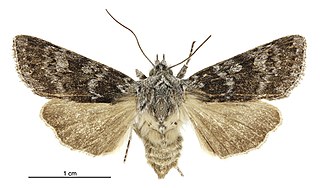
Physetica cucullina is a species of moth of the family Noctuidae. It is endemic to New Zealand and can be found throughout the South Island, apart from in the Nelson district with the exception of the St Arnaud Range where it is present. It is likely to be also resident in Stewart Island. P. cucullina lives in shrubland at subalpine and alpine zones but can occur at sea-level in the more southern regions. The life history of this species is poorly documented. There is only one known record in the New Zealand Arthropod Collection of the larvae of this species having been reared. These larvae were reared on Leucopogon fraseri. Adults of this species is on the wing from October to March and are attracted to light. P. cucullina is almost identical in appearance to P. funerea. The only reliable distinguishing feature between the two species is the antennae of the male. P. cucullina is also very similar in appearance to P. sequens but P. sequens lacks the narrow black line on the forewing dorsum area that can be present on the forewings of P. cucullina.





















